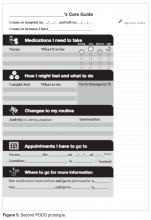Discussion
Innovative methods such as co-design events and targeted focus groups are very useful for
engaging patients and caregivers in the design and development of solutions aimed at improving their experience of care, resulting in solutions that are more successful. It is important to include all users, especially those who are harder to reach, such as patients with language barriers and mental health conditions. In addition, engaging health care providers is essential to ensure feasibility of those solutions. During the co-design process, it was difficult to truly engage harder-to-reach patient populations. At first, we tried using traditional methods of engagement such as approaching patient advisory boards and posting flyers for focus groups; however, although patients agreed to participate, very few had extreme language barriers or limited health literacy. As such, considerable time and effort was made to target harder-to-reach patients by enlisting interpreters, having flyers translated, and offering incentives. Additionally, we made use of ongoing patient meeting groups of patients with mental health issues and had health care providers screen patients for limited health literacy.
Future Plans
The PODS template has now been adapted and implemented in several hospitals in Toronto, Canada, using a supported early adopter process [10]. Future plans are to test the impact of the PODS on patient experience and health outcomes using a randomized controlled trial. Also, for now, we have focused on a paper version of PODS, but with the increasing prevalence of electronic health records and consumer-oriented health care apps, future consideration for a digital and mobile version of PODS is warranted.
Conclusion
Patients need to be prepared for discharge so that they can engage in supported self-management once they return home.
The PODS is one way to support this process and provides a resource that patients can repeatedly refer to once they are discharged. Care should be taken to include key information that is helpful for patients and to provide that information in a way that patients can understand and use. The PODS should incorporate important design elements for patients with low health literacy and language and visual barriers such as using plain language, large fonts, and visuals.Corresponding author: Shoshana Hahn-Goldberg, PhD, 294 Mullen Dr., Thornhill, ON L4J 2P2.
Funding/support: The PODS project has been funded by the Toronto Central Local Health Integration Network.
Financial disclosures: None.




